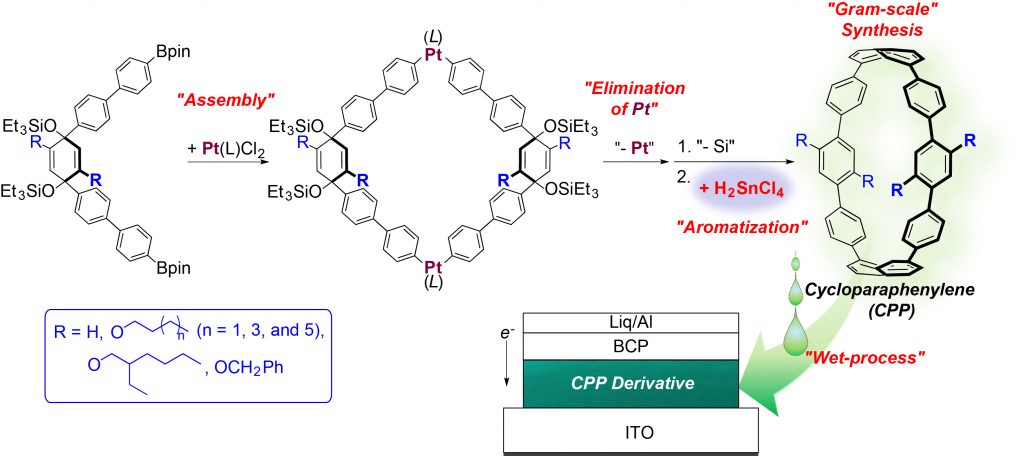Large scale synthesis of “carbon nanorings” and their fabrication to organic device
Published in “Journal of the American Chemical Society” (Online Publication, November 30, 2017).
(Polymer Controlled Synthesis, Division of Synthetic Chemistry)
Prof. Kaji, H.; Assist Prof. Suzuki, K.; Assist Prof. Fukushima, T.; Ms. Sawada, A.
(Molecular Material Chemistry, Division of Environmental Chemistry)
“Carbon nanorings” such as cycloparaphenylenes (CPPs), which possessing the simplest cyclic structural unit of armchair carbon nanotubes (CNTs), have received considerable attention because of their fascinating structures, associated distinct properties, and potential application in materials science and technology. The recent success in the bottom-up syntheses of CPPs and their derivatives has opened diverse research activities. However, despite these developments, the quantity of CPPs and their derivatives that has been synthesized is quite limited. This lack of availability limits their applications in materials sciences, such as electronic, optical, and optoelectronic materials.
The research group succeeded in the synthesis of [10]CPP (where [10] refers to the number of benzene units in the CPP) and its tetraalkoxy derivatives on the gram-scale in short-step with high overall yields. The key steps are the platinum-mediated dimerization of a five-ring unit containing cyclohexa-1,4-diene-3,6-diol moiety and the H2SnCl4-mediated reductive aromatization of cyclohexadienediol. The tetraalkoxy substituents increased the solubility of [10]CPP in common organic solvents and facilitate film fabrication by wet processes. The carrier-transport properties of thin films of [10]CPP and its derivatives were measured for the first time and indicated that [10]CPP derivatives could rival fullerene derivative such as phenyl-C61-butyric acid methyl ester (PCBM), which is used widely as an n-type active layer in bulk heterojunction photovoltaics. Due to the highly tunable electronic properties of CPPs by structural modification and their excellent availability, CPP derivatives would be excellent candidates to substitute PCBM. This study will open a new gate to utilize “carbon nanorings” for molecular electronics.

This work was partly supported by the Japan Society for the Promotion of Science KAKENHI Grant No. 26410043 (E.K.) and 16H06352 (S.Y.) and the Collaborative Research Program at the Institute for Chemical Research (ICR), Kyoto University. Computation was supported by the Super Computer Laboratory, ICR, Kyoto University.
